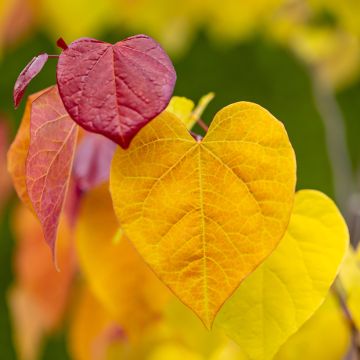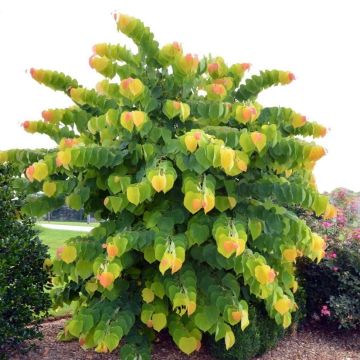

Cercis canadensis Red Force - Eastern Redbud


Cercis canadensis Red Force - Eastern Redbud
Cercis canadensis Red Force - Eastern Redbud
Cercis canadensis Red Force
Eastern Redbud, Canadian Redbud, American Redbud, Judas Tree
This item cannot be shipped to the selected country
Delivery charge from €5.90
Delivery to Corse prohibited
More information
Schedule delivery date,
and select date in basket
This plant carries a 24 months recovery warranty
More information
We guarantee the quality of our plants for a full growing cycle, and will replace at our expense any plant that fails to recover under normal climatic and planting conditions.
From €5.90 for pickup delivery and €6.90 for home delivery
Express home delivery from €8.90.
Delivery to Corse prohibited: UE law prohibits the import of this plant from mainland France to Corse as part of the fight against Xylella fastidiosa. Please accept our sincere apologies.
More information
Does this plant fit my garden?
Set up your Plantfit profile →
Description
Cercis Canadensis 'Red Force' is a variety of Eastern Redbud whose foliage displays a beautiful purple hue, darker than the Forest Pansy variety. Like its more common cousin, the Judas tree with its pink flowers, this small tree produces numerous clusters of flowers before the leaves, in the month of April. At the end of flowering, delicately heart-shaped leaves emerge. They remain purple throughout the growing season and evolve into shades of orange-red in autumn. Easy to grow, this Redbud thrives in various soils, even slightly chalky, and is resistant to pollution, making it an ideal choice for small urban gardens.
The Cercis canadensis is a tree native to the eastern and central United States, belonging to the large family Fabaceae (formerly known as Leguminosae). It can reach a height of 12m (39 ft 5 in) in its natural habitat but rarely exceeds 4 to 7m (13 ft 1 in to 23 ft) in cultivation. It forms a more or less twisted, low-branched tree, often wider than it is tall. The Canadian Redbud has given rise to many varieties with different habits, flower colors, and foliage.
Cercis canadensis 'Red Force' is a recent French selection (2010), still not widely available in gardens, but its numerous qualities will undoubtedly contribute to its dissemination. This variety reaches about 5m (16 ft 5 in) in height in 10 years, with a spread of about 3m (9 ft 10 in), and has a relatively upright habit compared to other Redbuds. The flowering occurs in April: the branches, still devoid of leaves, are then adorned with a superb pink flowering. The flowers are particularly abundant, papilionaceous, grouped in clusters along the branches and even on the trunk, which often surprises novice gardeners. Once the flowering is over, this Canadian Redbud is adorned with heart-shaped leaves, purple in color until autumn. It then takes on beautiful shades of orange-red to end the year in splendor!
This pretty little tree, particularly decorative in spring and autumn, is very hardy and can be planted in all regions of France. Not demanding, it adapts to different types of soils (even tolerating some limestone) as long as they are well-drained. Preferring full sun, it also tolerates partial shade and does not require any specific pruning. It is a very accommodating plant and valuable for small gardens, especially in urban areas, as it withstands atmospheric pollution well.
Its abundant pink flowering will perfectly complement white-flowering shrubs, such as the numerous spring spireas, from the small Spiraea cinerea 'Grefsheim' with its slender branches covered in flowers, to the more imposing Japanese spirea 'Snowmound' with its easy cultivation. The golden foliage will create a strong contrast with the purple of our Redbud, creating spectacular plantings throughout the season. The bright Physocarpus 'Angel Gold' will also offer its late white flowering, followed by red fruits until autumn, a simple combination to achieve for a decorative scene from spring to autumn!
Report an error about the product description
Cercis canadensis Red Force - Eastern Redbud in pictures




Plant habit
Flowering
Foliage
Botanical data
Cercis
canadensis
Red Force
Fabaceae
Eastern Redbud, Canadian Redbud, American Redbud, Judas Tree
Cultivar or hybrid
Other Cercis
Planting and care
Cercis canadensis 'Red Force' loves warm and sunny situations, but also adapts to partial shade. It is not picky about the nature of the soil, as long as it is deep and retains some moisture, but also drains well. In poor soil, enrich the planting area with good quality compost or potting soil.
Water it regularly during the first seasons in case of drought: the Eastern redbud fears long periods of summer drought, unlike its Mediterranean cousin, Cercis siliquastrum, which is fully adapted to dry and rocky, even arid, soils. It can tolerate all soil types but prefers neutral or acidic soils. It is perfectly hardy (-20 °C (-4 °F)), but the flowering may suffer in the event of severe frost at the beginning of spring. Protection with winter fleece can be useful during the first few years in case of a cold spell in March.
Planting period
Intended location
Care
This item has not been reviewed yet - be the first to leave a review about it.
Haven't found what you were looking for?
Hardiness is the lowest winter temperature a plant can endure without suffering serious damage or even dying. However, hardiness is affected by location (a sheltered area, such as a patio), protection (winter cover) and soil type (hardiness is improved by well-drained soil).

Photo Sharing Terms & Conditions
In order to encourage gardeners to interact and share their experiences, Promesse de fleurs offers various media enabling content to be uploaded onto its Site - in particular via the ‘Photo sharing’ module.
The User agrees to refrain from:
- Posting any content that is illegal, prejudicial, insulting, racist, inciteful to hatred, revisionist, contrary to public decency, that infringes on privacy or on the privacy rights of third parties, in particular the publicity rights of persons and goods, intellectual property rights, or the right to privacy.
- Submitting content on behalf of a third party;
- Impersonate the identity of a third party and/or publish any personal information about a third party;
In general, the User undertakes to refrain from any unethical behaviour.
All Content (in particular text, comments, files, images, photos, videos, creative works, etc.), which may be subject to property or intellectual property rights, image or other private rights, shall remain the property of the User, subject to the limited rights granted by the terms of the licence granted by Promesse de fleurs as stated below. Users are at liberty to publish or not to publish such Content on the Site, notably via the ‘Photo Sharing’ facility, and accept that this Content shall be made public and freely accessible, notably on the Internet.
Users further acknowledge, undertake to have ,and guarantee that they hold all necessary rights and permissions to publish such material on the Site, in particular with regard to the legislation in force pertaining to any privacy, property, intellectual property, image, or contractual rights, or rights of any other nature. By publishing such Content on the Site, Users acknowledge accepting full liability as publishers of the Content within the meaning of the law, and grant Promesse de fleurs, free of charge, an inclusive, worldwide licence for the said Content for the entire duration of its publication, including all reproduction, representation, up/downloading, displaying, performing, transmission, and storage rights.
Users also grant permission for their name to be linked to the Content and accept that this link may not always be made available.
By engaging in posting material, Users consent to their Content becoming automatically accessible on the Internet, in particular on other sites and/or blogs and/or web pages of the Promesse de fleurs site, including in particular social pages and the Promesse de fleurs catalogue.
Users may secure the removal of entrusted content free of charge by issuing a simple request via our contact form.
The flowering period indicated on our website applies to countries and regions located in USDA zone 8 (France, the United Kingdom, Ireland, the Netherlands, etc.)
It will vary according to where you live:
- In zones 9 to 10 (Italy, Spain, Greece, etc.), flowering will occur about 2 to 4 weeks earlier.
- In zones 6 to 7 (Germany, Poland, Slovenia, and lower mountainous regions), flowering will be delayed by 2 to 3 weeks.
- In zone 5 (Central Europe, Scandinavia), blooming will be delayed by 3 to 5 weeks.
In temperate climates, pruning of spring-flowering shrubs (forsythia, spireas, etc.) should be done just after flowering.
Pruning of summer-flowering shrubs (Indian Lilac, Perovskia, etc.) can be done in winter or spring.
In cold regions as well as with frost-sensitive plants, avoid pruning too early when severe frosts may still occur.
The planting period indicated on our website applies to countries and regions located in USDA zone 8 (France, United Kingdom, Ireland, Netherlands).
It will vary according to where you live:
- In Mediterranean zones (Marseille, Madrid, Milan, etc.), autumn and winter are the best planting periods.
- In continental zones (Strasbourg, Munich, Vienna, etc.), delay planting by 2 to 3 weeks in spring and bring it forward by 2 to 4 weeks in autumn.
- In mountainous regions (the Alps, Pyrenees, Carpathians, etc.), it is best to plant in late spring (May-June) or late summer (August-September).
The harvesting period indicated on our website applies to countries and regions in USDA zone 8 (France, England, Ireland, the Netherlands).
In colder areas (Scandinavia, Poland, Austria...) fruit and vegetable harvests are likely to be delayed by 3-4 weeks.
In warmer areas (Italy, Spain, Greece, etc.), harvesting will probably take place earlier, depending on weather conditions.
The sowing periods indicated on our website apply to countries and regions within USDA Zone 8 (France, UK, Ireland, Netherlands).
In colder areas (Scandinavia, Poland, Austria...), delay any outdoor sowing by 3-4 weeks, or sow under glass.
In warmer climes (Italy, Spain, Greece, etc.), bring outdoor sowing forward by a few weeks.













































